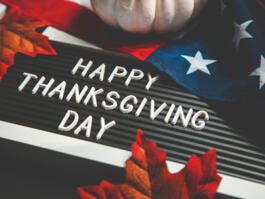Giving Thanks for the Leftovers
A Commentary By Froma Harrop
Thanksgiving is upon us. This is the time for expressing gratitude. But what does one do on Thanksgiving this year, smack in the middle of perhaps the worst economic downturn since the Great Depression? You give thanks, dummy.
And you marvel that while stocks have crashed, home values tanked and unemployment lines grown, no one is going hungry for lack of available food. The poorest among us can still turn to food banks, soup kitchens and Food Stamps. Most American families, even those suffering serious economic setbacks, will sit down for the sort of turkey dinner that peasants in hard times past would have considered unimaginable feasts.
We moderns are good at counting our losses, but not appreciating the leftovers. And that's what Thanksgiving is about, showing gratitude for whatever has been left us.
In that regard, Thanksgiving is almost un-American. It is a day opposed to striving, to getting more. It's time to stop adding up the numbers on the scorecard of life, to freeze in place, look around and give thanks for whatever is there.
Let's summon up some Thanksgiving spirit. Thanksgiving is a full-glass holiday. It is not a time to bemoan what one's house was worth last year. To be healthy, educated and living in this land of plenty is to have one's cup running over.
Our culture does not encourage contentment with what we already have. This is the land of the upgrade. One can always do better, be it with house or spouse. Every generation is supposed to live on a posher level than the one before. Some years ago, an investment company ran an advertisement showing a young woman sitting pensively on a front porch.
The ad read: "Your father did better than his father. Are you prepared to carry on the tradition?"
Note how the warm word "tradition" is used to cover a not-very-laudable activity: intergenerational competition.
Such thinking would have been wholly foreign to the Pilgrims who celebrated the first Thanksgiving. The events leading up to that dinner help us understand the very different mindset that inspired this holiday.
The Pilgrims were Puritans who had seceded from the Church of England. They made a grueling trek to North American so that they could worship as they chose. Their ship, the Mayflower, landed at what was to become Plymouth, Mass., on Dec. 16, 1620.
Mid-December is an awful time to establish quarters in the New England wilderness. Disease immediately carried off more than half of the 102 colonists. They were buried on Coles Hill, right across the street from Plymouth Rock. (Scholars now believe that the Mayflower really did land there.) Without the help of friendly Indians, the colony would have vanished before spring.
In 1625, the colony's governor, William Bradford, wrote that the Pilgrims "never felt the sweetness of the country till this year." But that didn't sop them from giving thanks four years earlier.
The first Thanksgiving was held in the autumn of 1621. The purpose was not to celebrate the good life, but to celebrate survival. The Wampanoag Indians shared in the dinner.
By the 1830s, America had become a bustling place of fortune-building and otherwise improving one's material lot. Intellectuals of the day looked back nostalgically at the Puritan concern with unworldly matters. Ralph Waldo Emerson, for one, spoke of the Purtians' religious orientation as "an antidote to the spirit of commerce and economy."
Thanksgiving is a throwback to that misty past. It asks for a Zen-like acceptance of the present.
So put down that 401(k) statement. Even if it says "zero," there is much to be thankful for.
COPYRIGHT 2008 THE PROVIDENCE JOURNAL CO.
DISTRIBUTED BY CREATORS SYNDICATE, INC.
Views expressed in this column are those of the author, not those of Rasmussen Reports.
See Other Political Commentary.
See Other Commentaries by Froma Harrop.
Rasmussen Reports is a media company specializing in the collection, publication and distribution of public opinion information.
We conduct public opinion polls on a variety of topics to inform our audience on events in the news and other topics of interest. To ensure editorial control and independence, we pay for the polls ourselves and generate revenue through the sale of subscriptions, sponsorships, and advertising. Nightly polling on politics, business and lifestyle topics provides the content to update the Rasmussen Reports web site many times each day. If it's in the news, it's in our polls. Additionally, the data drives a daily update newsletter and various media outlets across the country.
Some information, including the Rasmussen Reports daily Presidential Tracking Poll and commentaries are available for free to the general public. Subscriptions are available for $4.95 a month or 34.95 a year that provide subscribers with exclusive access to more than 20 stories per week on upcoming elections, consumer confidence, and issues that affect us all. For those who are really into the numbers, Platinum Members can review demographic crosstabs and a full history of our data.
To learn more about our methodology, click here.



